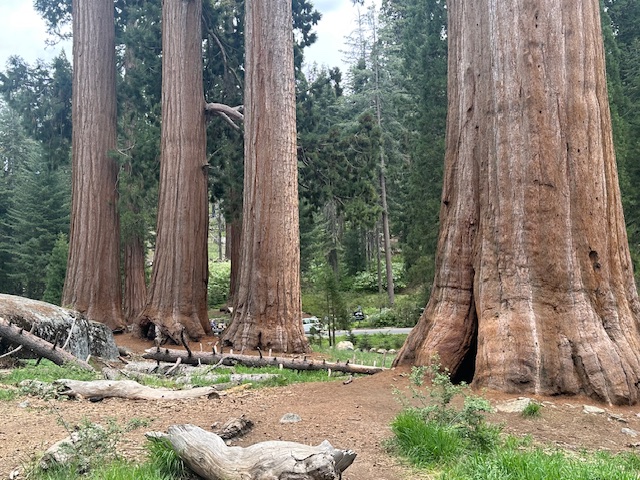Giant Slayers: What’s Killing 3,000-year-old Sequoias?
By Peter Schroeder
For many people, this journey is more like a pilgrimage. Others want to fulfill a life-long dream of seeing the oldest and largest living things on the planet. Some yearn simply to walk among Giants.
Giant Sequoias (Sequoiadendron giganteum) reign as the Monarchs of the Forest. They grow only above the 6,000-foot elevation within a narrow, nine-mile-wide corridor that extends 250 miles along the western slopes of the Sierra Nevada range. The largest concentrations of these trees flourish in namesake Sequoia National Park.
Centerpiece of the park is the sequoia, General Sherman, the largest living entity on earth by volume and by weight. Standing 275 feet and with a base circumference of 105 feet, this colossal tree has a mass of 53 million cubic feet, equal to more than 1,500 tons.
That said, General Sherman is not the world’s oldest tree. That honor is claimed by Methuselah, a 4,600-year-old bristlecone pine in California’s Inyo National Forest. An estimated 3,000 years old, General Sherman was a seedling 1,000 years before the Christian era, but several of its brethren in a nearby grove date back another 500 years.
Nor are sequoias the tallest trees. That honor goes to its species cousins, the coastal redwoods (Sequoia sempervirens), specifically Helion, towering at 360 feet.
Why? There’s a limit to how high a tree can pump its internal life-sustaining water. Coastal redwoods cadge additional moisture from the fog banks that roll in from the Pacific. Set in the mountains east of California’s Central Valley, the giant sequoias have no such access.
But all is not well. Having survived thousands of fires and droughts over the millennia, the 25,000 sequoias found in Sequoia and Kings Canyon National Parks are in danger from three new threats.
Climate Change
Although these forests have survived other eras of temperature increases, excessive rainfalls, and droughts, the difference today is the speed at which these changes occur.
As the planet warms, it creates prolonged, hotter droughts. Less snowmelt in the mountains deprives forests of much-needed water. During California’s 2012–2016 drought, the most extreme in recent records, scientists and park managers observed widespread foliage dieback and documented 33 giant sequoias that died.
The interaction of hotter weather and shifts in snowmelt and rainfall has altered the environment in which sequoias have evolved and thrived. With temperatures expected to rise significantly this century, scientists worry that changes in climate and precipitation could doom the trees.
Fire
Naturally fire-adapted, giant sequoias have lived with fire for thousands of years. Their thick, spongy bark, which can grow up two feet thick, protects the inner core of the trunk and insulates the trees from heat injury. Furthermore, the branches of large sequoias grow high enough to avoid the flames of most fires. The species is actually designed to benefit from fire because the heat releases seeds from cones. Seedlings take root in the open where fire clears away competitive vegetation.
However, more severe conflagrations in recent years have damaged or killed an increasing number of large sequoias. In 2021, when the General Sherman was threatened by the KNP Complex Fire in Sequoia National Park, firefighters wrapped the tree’s base in a protective foil, which kept it safe. Covering helps prevent fire from burning into tree bases and creating vulnerable fire scars.
An estimated 20 percent of the world’s giant sequoias were killed by fires over the past century. Most casualties resulted from flames in the canopy, known as crown scorch. In the past century, misguided forestry management practices calling for all fires to be extinguished caused an increased amount of underbrush. As a result, wildfires are now more common and burn hotter than ever.
Bark Beetles
A relatively new threat to the giant sequoias is the western cedar bark beetle (Phloeosinus punctatus), native to the Sierras. Sequoias had been thought to be resistant to native bark beetles, but in recent years several of these trees have succumbed to significant beetle infestations. Beetles have always preyed on weak trees, mostly firs and pines, but sequoias have been immune due to the tannins in their thick bark that repel most pests. However, beetles are now considered a major threat leading to the sequoias’ decline.
Many sequoias died following the 2014 – 2016 drought in areas where they had been previously injured by extreme fires. The combination of drought-stress and fire-injury weakened the trees enough that the beetles—actually swarming armies of beetles—could take their toll. Studies show that beetles attack the tree’s canopy potentially leading to its death within six months, Warmer weather has also led to an increase of the beetle populations.
Although sequoias co-existed with beetles for centuries, things have changed because of stresses from the warming climate. Scientists hope that this is a temporary phenomenon.
Visalia
If you want to walk among the Monarchs of the Forest, your best place to overnight is Visalia, California, known as “Gateway to the Sequoias,” located about three hour’s drive from the nearest major cities. The county seat of Tulare County (the largest agricultural producing county in the nation) offers accommodations and restaurants that range from basic to high-end luxurious.
From Visalia, it’s about an hour’s drive to the Sequoia National Park. Once past the ranger’s gate, you’ll need an additional hour to drive through scenic sequoia forests on well-maintained, paved roads to reach the General Sherman.
# # #




